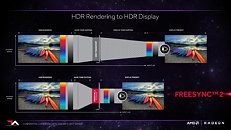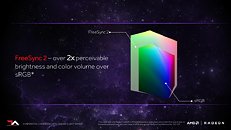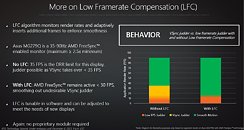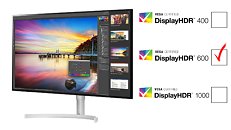Thursday, June 21st 2018

AMD to Rename "FreeSync 2" To "FreeSync 2 HDR", Increase Minimum HDR Requirement
The guys over at PC Perspective conducted an interesting interview with AMD, during which a company representative talked about impending changes to AMD's FreeSync program. Essentially, the company found that there is some consumer confusion regarding what features exactly FreeSync 2 delivers over its first-gen counterpart. As such, they feel renaming the technology to FreeSync 2 HDR conveys the focus on the new feature-set: LFC (Low Framerate Compensation) and the FreeSync 2 HDR fast-lane for tone-mapping improvements.
The AMD representative further clarified what specs are required for a monitor to receive FreeSync 2 HDR certification: support for at least HDR600, coverage of 99 percent of BT.709 and 90 percent of the DCI P3 color spectrum. Also mentioned was a minimum response time, though the exact value remains unknown. An interesting point that can be gleaned from AMD's change, though, is that this one is more than just cosmetic: AMD's first FreeSync 2 certification program required displays to only be able to adhere to HDR400. There are some examples of announced, FreeSync 2 monitors that only support that standard (and others that don't support even that but were certified all the same), instead of the aforementioned HDR600 the company will apparently start enforcing alongside the renewed "FreeSync 2 HDR" program. Here's hoping for a stricter certification program from AMD in this regard, since HDR400 was a push in itself towards being true HDR (it isn't...) - and FreeSync 2 already has all the market support and recognition it needs to now start increasing its requirements for quality support instead of mainly quantity.
Source:
PC Perspective
The AMD representative further clarified what specs are required for a monitor to receive FreeSync 2 HDR certification: support for at least HDR600, coverage of 99 percent of BT.709 and 90 percent of the DCI P3 color spectrum. Also mentioned was a minimum response time, though the exact value remains unknown. An interesting point that can be gleaned from AMD's change, though, is that this one is more than just cosmetic: AMD's first FreeSync 2 certification program required displays to only be able to adhere to HDR400. There are some examples of announced, FreeSync 2 monitors that only support that standard (and others that don't support even that but were certified all the same), instead of the aforementioned HDR600 the company will apparently start enforcing alongside the renewed "FreeSync 2 HDR" program. Here's hoping for a stricter certification program from AMD in this regard, since HDR400 was a push in itself towards being true HDR (it isn't...) - and FreeSync 2 already has all the market support and recognition it needs to now start increasing its requirements for quality support instead of mainly quantity.




13 Comments on AMD to Rename "FreeSync 2" To "FreeSync 2 HDR", Increase Minimum HDR Requirement
"AMD's first FreeSync 2 certification program required displays to only be able to adhere to HDR400. There are some examples of announced, FreeSync 2 monitors that only support that standard (and others that don't support even that but were certified all the same)"
AMD promised that Freesync 2 comes with HDR by default. But from all Freesync 2 monitors only few were certified HDR400, 600 (maybe more didn't check). Now they call it Freesync 2 HDR because only now those monitors will come with DisplayHDR 400, 600, 1000 nits.
FreeSync 2 spec was created before VESA put out the DisplayHDR standard. AMD updated FreeSync 2 spec to use the definitions VESA established. There's only three FreeSync 2 certified monitors right now and all three exceed DisplayHDR 600.
There will likely be DisplayHDR 1000 FreeSync 2 certified TVs.
I welcome this change. Less confusing for everyone.
FYI, DisplayHDR 400......most monitors are 300-350 nit but lack region lighting.